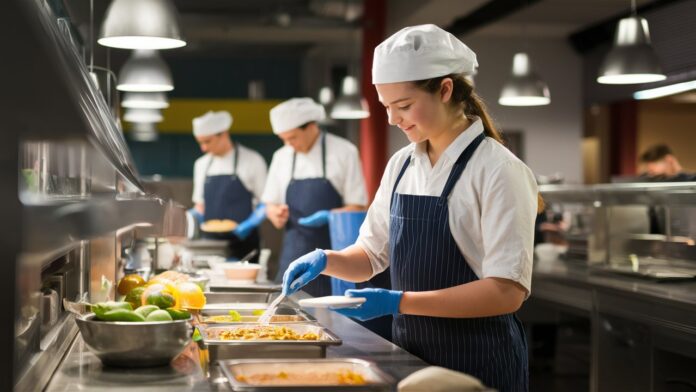Ensuring food safety in a cafeteria is crucial for protecting the health of your patrons and maintaining a positive reputation. Proper food handling practices not only prevent foodborne illnesses but also promote a clean and efficient operation. Here are the top 10 tips for ensuring food safety in your cafeteria.
1. Follow Proper Handwashing Techniques
Handwashing is the first line of defense against foodborne illnesses. Employees must wash their hands thoroughly with soap and water for at least 20 seconds before handling food, after using the restroom, and after touching any potentially contaminated surfaces. Providing handwashing stations equipped with soap, warm water, and disposable towels or air dryers is essential for maintaining hygiene standards.
2. Maintain Proper Food Storage
Proper food storage is essential to prevent contamination and spoilage. Keep raw meats, poultry, and seafood separate from ready-to-eat foods to avoid cross-contamination. Use clearly labeled, airtight containers to maintain freshness and minimize contamination risks.
Regularly check and maintain the temperatures of your refrigerator and freezer to ensure they remain safe: below 40°F (4°C) for the refrigerator and 0°F (-18°C) for the freezer. Additionally, ensure your reach-in cooler in Hawaii is well-maintained and promptly repaired to prevent temperature fluctuations and potential food safety issues.
3. Practice Safe Food Handling
When preparing food, always use separate cutting boards and utensils for raw and cooked foods to prevent cross-contamination. Cook foods to the recommended internal temperatures to kill harmful bacteria. For example, poultry should reach an internal temperature of 165°F (74°C), while ground meats should be cooked to at least 160°F (71°C). Use a food thermometer to verify temperatures and ensure safety.
4. Implement a Clean As You Go Policy
A clean workspace is a safe workspace. Encourage staff to clean and sanitize surfaces and equipment frequently throughout their shift. This practice helps prevent the buildup of harmful bacteria and reduces the risk of contamination. Provide employees with access to sanitizing solutions and cleaning supplies, and ensure they understand the importance of regular cleaning.
5. Ensure Proper Training for All Staff
Comprehensive food safety training for all staff members is essential.Training should cover proper handwashing techniques, safe food handling practices, and the importance of maintaining a clean environment. Regular refresher courses and updates on food safety guidelines will help keep staff informed and compliant with best practices.
6. Monitor and Control Pest Activity
Pests can be a significant source of food contamination. Implement pest control measures such as regular inspections, proper waste management, and sealing entry points to prevent pests from entering the cafeteria. Establish a partnership with a pest control professional to address any infestations promptly and effectively.
7. Maintain Proper Temperature Control
Temperature control is crucial for food safety. Keep hot foods hot and cold foods cold to prevent bacterial growth. Use heat lamps or chafing dishes to maintain the temperature of hot foods and ensure cold foods are stored on ice or in refrigerated units. Regularly check and document temperatures to ensure compliance with safety standards.
8. Enforce Personal Hygiene Standards
Employees must adhere to strict personal hygiene standards to prevent food contamination. This includes wearing clean uniforms, tying back long hair, and avoiding touching their face while handling food. Additionally, staff should avoid working while sick, particularly with symptoms of gastrointestinal illness, to prevent the spread of pathogens.
9. Establish a Robust Cleaning Schedule
A well-defined cleaning schedule is essential for maintaining a sanitary cafeteria environment. Develop a routine cleaning plan that includes daily, weekly, and monthly tasks. This should cover all areas, including kitchen surfaces, floors, equipment, and storage areas. Regularly review and update the schedule to ensure thorough and consistent cleaning.
10. Conduct Regular Food Safety Audits
Regular food safety audits help identify potential issues and ensure compliance with food safety standards. Conduct internal audits or engage third-party inspectors to evaluate your cafeteria’s food safety practices. Use the findings to address any deficiencies and continuously improve your food safety protocols.
In Conclusion
By implementing these top 10 tips, you can create a safer dining environment for your patrons and uphold high standards of food safety in your cafeteria. Consistent adherence to these practices not only prevents foodborne illnesses but also fosters trust and satisfaction among your customers. Prioritizing food safety is essential for the success and reputation of your cafeteria.




